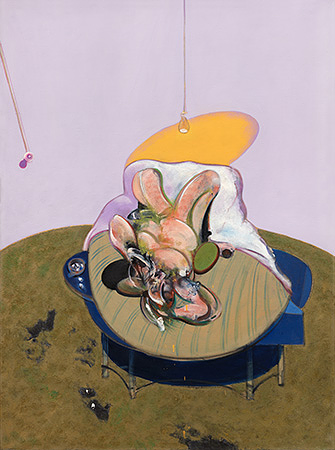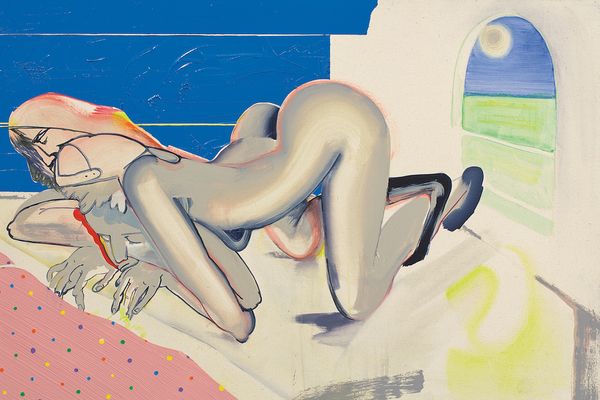Christina Quarles, Tuckt, 2016. Estimate $70,000 - 100,000. 20th Century and Contemporary Art New York.
Painted the same year she completed her MFA at Yale, Tuckt, 2016, demonstrates the sharp focus and technical skill that garnered Christina Quarles immediate recognition. Only one year after her graduation, Quarles’ work was exhibited in group exhibitions at the New Museum, New York and the Studio Museum, Harlem, where it received critical acclaim. Looking forward, Quarles will be the subject of a major solo exhibition at the Museum of Contemporary Art Chicago in 2021, which will be the largest presentation of her work to date.
In Tuckt, Quarles paints two gray-toned figures against an ambiguous background constructed from thick blue strips of impasto against an isolated window. The frontal figure bends over on all fours and arches towards a set of dotted pink sheets, while beside them, another figure sweeps forward in an identical pose. Although Quarles has contoured these genderless bodies with wisps of red pigment, once the viewer’s eye traces the hips of the subjects, the two once-distinct figures fuse into a single being where it becomes impossible to determine the point of separation. It is this fragmentation of perception and imperceptibility of identity that uniquely characterizes Quarles’ vivid paintings as well as her lived experience.

Francis Bacon, Lying Figure, 1969 (CR-69-03). Fondation Beyeler, Riehen / Basel, Artwork © 2020 Estate of Francis Bacon / Artists Rights Society (ARS), New York / DACS, London.
Through her practice, Quarles brings her own multifaceted positions on race and sexuality to the forefront. Born to a Black father and a white mother, Quarles has moved through several spaces where her own Black heritage has become illegible. Her outward appearance resists the immediate and constrained classification that race encourages, and this schism between what she believes of her own identity and how others perceive her has evolved into a conflict that she readily explores in her oeuvre. As a result, Quarles defies categorization and expertly uses a varied visual lexicon. In Tuckt, her gestural brushstrokes evoke the memory of abstract expressionism while the severing of context and dislocation of a preconceived logic recalls the more radical aspects of surrealism.
Quarles’s identification as a queer woman also plays a prominent role in her work, as many of her paintings highlight the erotic nature of abstraction. The indeterminate appearance of the body (or bodies) represented in Tuckt, is akin to the amorphous figure presented in Francis Bacon’s Lying Figure, 1969. In Lying Figure, Bacon portrays a nude, contorted figure who rests within an unspecified room underneath the skewed halo of a lightbulb. For both artists, this disruption of time and space and its ability to transform the familiar is key to a painting’s success.
Discover More from 20th Century and Contemporary Art >

Recommended Reading
Joan Mitchell in Another Dimension >
